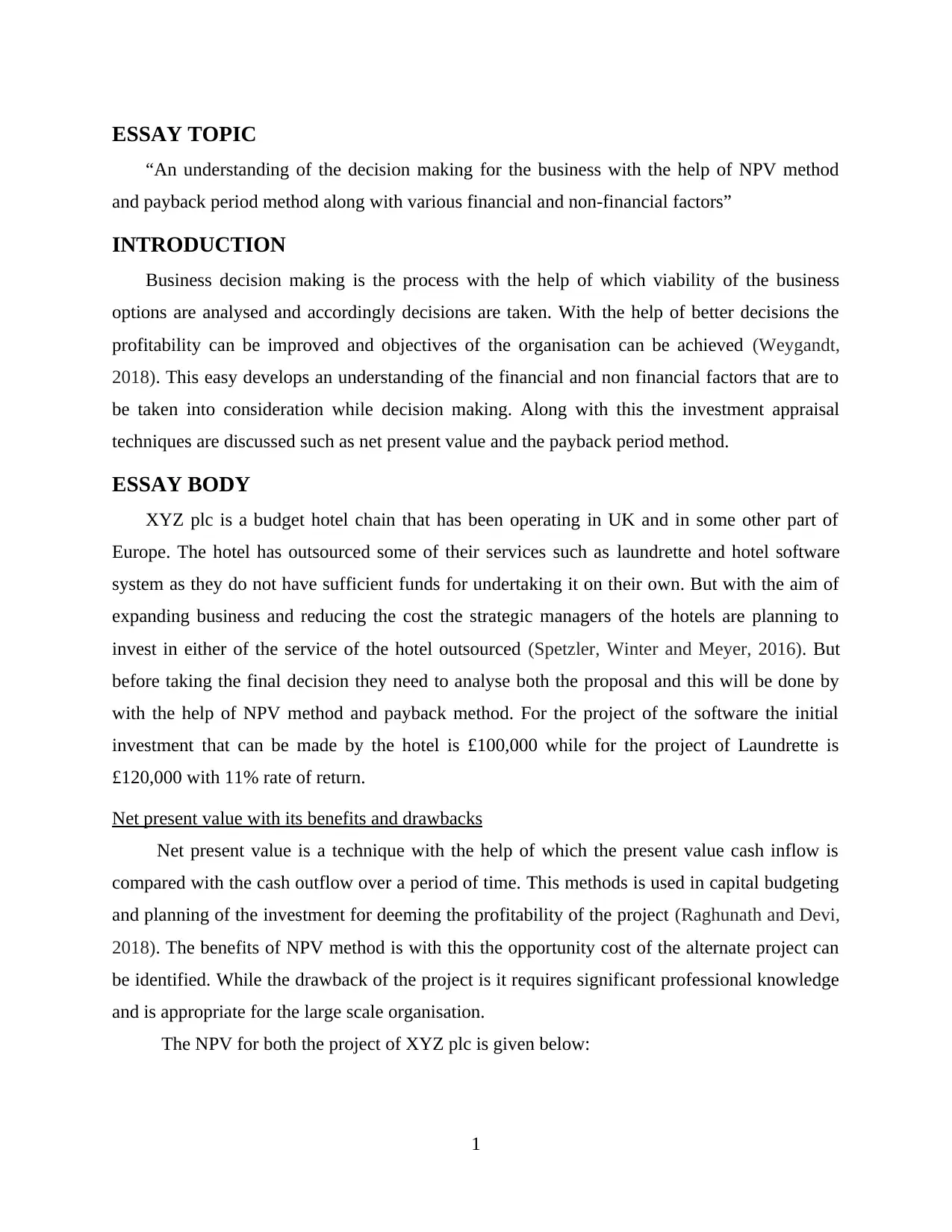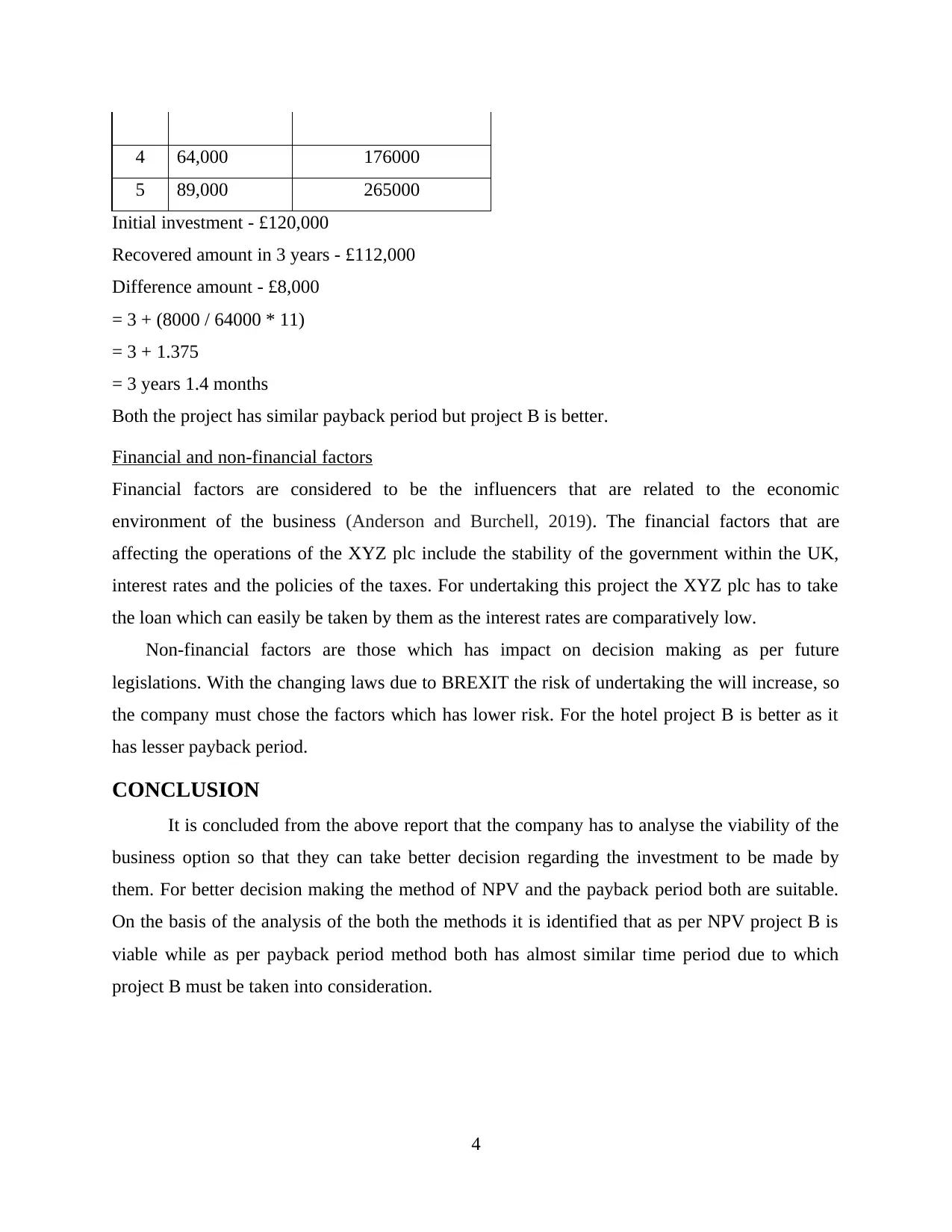Business Decision Making with NPV and Payback Period Methods
VerifiedAdded on 2023/01/11
|7
|1301
|63
AI Summary
This essay explores the decision making process for businesses using the NPV and payback period methods. It discusses the benefits and drawbacks of these methods and provides a case study on XYZ plc. The essay also highlights the importance of considering financial and non-financial factors in decision making.
Contribute Materials
Your contribution can guide someone’s learning journey. Share your
documents today.

Essay on business decision
making
making
Secure Best Marks with AI Grader
Need help grading? Try our AI Grader for instant feedback on your assignments.

Contents
ESSAY TOPIC................................................................................................................................1
INTRODUCTION...........................................................................................................................1
ESSAY BODY................................................................................................................................1
Net present value with its benefits and drawbacks......................................................................1
Payback period with its benefits and drawbacks.........................................................................3
Financial and non-financial factors.............................................................................................4
CONCLUSION................................................................................................................................4
REFERENCES................................................................................................................................5
ESSAY TOPIC................................................................................................................................1
INTRODUCTION...........................................................................................................................1
ESSAY BODY................................................................................................................................1
Net present value with its benefits and drawbacks......................................................................1
Payback period with its benefits and drawbacks.........................................................................3
Financial and non-financial factors.............................................................................................4
CONCLUSION................................................................................................................................4
REFERENCES................................................................................................................................5

ESSAY TOPIC
“An understanding of the decision making for the business with the help of NPV method
and payback period method along with various financial and non-financial factors”
INTRODUCTION
Business decision making is the process with the help of which viability of the business
options are analysed and accordingly decisions are taken. With the help of better decisions the
profitability can be improved and objectives of the organisation can be achieved (Weygandt,
2018). This easy develops an understanding of the financial and non financial factors that are to
be taken into consideration while decision making. Along with this the investment appraisal
techniques are discussed such as net present value and the payback period method.
ESSAY BODY
XYZ plc is a budget hotel chain that has been operating in UK and in some other part of
Europe. The hotel has outsourced some of their services such as laundrette and hotel software
system as they do not have sufficient funds for undertaking it on their own. But with the aim of
expanding business and reducing the cost the strategic managers of the hotels are planning to
invest in either of the service of the hotel outsourced (Spetzler, Winter and Meyer, 2016). But
before taking the final decision they need to analyse both the proposal and this will be done by
with the help of NPV method and payback method. For the project of the software the initial
investment that can be made by the hotel is £100,000 while for the project of Laundrette is
£120,000 with 11% rate of return.
Net present value with its benefits and drawbacks
Net present value is a technique with the help of which the present value cash inflow is
compared with the cash outflow over a period of time. This methods is used in capital budgeting
and planning of the investment for deeming the profitability of the project (Raghunath and Devi,
2018). The benefits of NPV method is with this the opportunity cost of the alternate project can
be identified. While the drawback of the project is it requires significant professional knowledge
and is appropriate for the large scale organisation.
The NPV for both the project of XYZ plc is given below:
1
“An understanding of the decision making for the business with the help of NPV method
and payback period method along with various financial and non-financial factors”
INTRODUCTION
Business decision making is the process with the help of which viability of the business
options are analysed and accordingly decisions are taken. With the help of better decisions the
profitability can be improved and objectives of the organisation can be achieved (Weygandt,
2018). This easy develops an understanding of the financial and non financial factors that are to
be taken into consideration while decision making. Along with this the investment appraisal
techniques are discussed such as net present value and the payback period method.
ESSAY BODY
XYZ plc is a budget hotel chain that has been operating in UK and in some other part of
Europe. The hotel has outsourced some of their services such as laundrette and hotel software
system as they do not have sufficient funds for undertaking it on their own. But with the aim of
expanding business and reducing the cost the strategic managers of the hotels are planning to
invest in either of the service of the hotel outsourced (Spetzler, Winter and Meyer, 2016). But
before taking the final decision they need to analyse both the proposal and this will be done by
with the help of NPV method and payback method. For the project of the software the initial
investment that can be made by the hotel is £100,000 while for the project of Laundrette is
£120,000 with 11% rate of return.
Net present value with its benefits and drawbacks
Net present value is a technique with the help of which the present value cash inflow is
compared with the cash outflow over a period of time. This methods is used in capital budgeting
and planning of the investment for deeming the profitability of the project (Raghunath and Devi,
2018). The benefits of NPV method is with this the opportunity cost of the alternate project can
be identified. While the drawback of the project is it requires significant professional knowledge
and is appropriate for the large scale organisation.
The NPV for both the project of XYZ plc is given below:
1

PROJECT A: Software
Year Net cash
flow (A)
PV factor
Calculation
PV factor @
11% (B)
Discounted cash
flow (A*B)
1 28,000 1/(1+0.11) 0.9009009 25225.23
2 32,000 1/(1+0.11)^2 0.81162243 25971.92
3 35,000 1/(1+0.11)^3 0.73119138 25591.7
4 55,000 1/(1+0.11)^4 0.65873097 36230.2
5 78,000 1/(1+0.11)^5 0.59345133 46289.2
Total discounted
cash flow
159308.2
Less: initial
investment (0) 100000
Net Present value 59308.25
PROJECT B: Laundrette
Year Net cash
flow (A)
PV factor
Calculation
PV factor @
11% (B)
Discounted cash
flow (A*B)
1 31,000 1/(1+0.11) 0.9009009 8928.571429
2 38,000 1/(1+0.11)^2 0.81162243 15943.87755
3 43,000 1/(1+0.11)^3 0.73119138 17794.5062
4 64,000 1/(1+0.11)^4 0.65873097 19065.54235
5 89,000 1/(1+0.11)^5 0.59345133 22697.07423
Total discounted
cash flow
185186.8
Less: initial
investment (0) 120000
Net Present
value
65186.76
2
Year Net cash
flow (A)
PV factor
Calculation
PV factor @
11% (B)
Discounted cash
flow (A*B)
1 28,000 1/(1+0.11) 0.9009009 25225.23
2 32,000 1/(1+0.11)^2 0.81162243 25971.92
3 35,000 1/(1+0.11)^3 0.73119138 25591.7
4 55,000 1/(1+0.11)^4 0.65873097 36230.2
5 78,000 1/(1+0.11)^5 0.59345133 46289.2
Total discounted
cash flow
159308.2
Less: initial
investment (0) 100000
Net Present value 59308.25
PROJECT B: Laundrette
Year Net cash
flow (A)
PV factor
Calculation
PV factor @
11% (B)
Discounted cash
flow (A*B)
1 31,000 1/(1+0.11) 0.9009009 8928.571429
2 38,000 1/(1+0.11)^2 0.81162243 15943.87755
3 43,000 1/(1+0.11)^3 0.73119138 17794.5062
4 64,000 1/(1+0.11)^4 0.65873097 19065.54235
5 89,000 1/(1+0.11)^5 0.59345133 22697.07423
Total discounted
cash flow
185186.8
Less: initial
investment (0) 120000
Net Present
value
65186.76
2
Secure Best Marks with AI Grader
Need help grading? Try our AI Grader for instant feedback on your assignments.

On the basis of this calculation it is identified that for project A, NPV is £59308 against initial
investment of £100000 while NPV id project B is £65186 against initial investment of £120000.
With this it can be identified that project B is more effective for the hotel.
Payback period with its benefits and drawbacks
With the help of Payback period method the time can be identified within which the
company can recover their initial investment. The benefits of this methods is the calculation of
this method is easy and can be used by the small scale companies while its drawback is that it
does not considers the time value of the money which can affect the decision of the organisation
(Cunningham, 2018).
The payback period for both the project of XYZ plc is given below:
PROJECT A: Software
Year Net cash flow Cumulative Cash Flow
1 28,000 28000
2 32,000 60000
3 35,000 95000
4 55,000 150000
5 78,000 228000
Initial investment - £100,000
Recovered amount in 3 years - £95,000
Difference amount - £5,000
Payback period = 3 + (5000 / 55000 * 11)
= 3 + 1
= 3 years 1 month
PROJECT B: Laundrette
Year Net cash flow Cumulative Cash Flow
1 31,000 31000
2 38,000 69000
3 43,000 112000
3
investment of £100000 while NPV id project B is £65186 against initial investment of £120000.
With this it can be identified that project B is more effective for the hotel.
Payback period with its benefits and drawbacks
With the help of Payback period method the time can be identified within which the
company can recover their initial investment. The benefits of this methods is the calculation of
this method is easy and can be used by the small scale companies while its drawback is that it
does not considers the time value of the money which can affect the decision of the organisation
(Cunningham, 2018).
The payback period for both the project of XYZ plc is given below:
PROJECT A: Software
Year Net cash flow Cumulative Cash Flow
1 28,000 28000
2 32,000 60000
3 35,000 95000
4 55,000 150000
5 78,000 228000
Initial investment - £100,000
Recovered amount in 3 years - £95,000
Difference amount - £5,000
Payback period = 3 + (5000 / 55000 * 11)
= 3 + 1
= 3 years 1 month
PROJECT B: Laundrette
Year Net cash flow Cumulative Cash Flow
1 31,000 31000
2 38,000 69000
3 43,000 112000
3

4 64,000 176000
5 89,000 265000
Initial investment - £120,000
Recovered amount in 3 years - £112,000
Difference amount - £8,000
= 3 + (8000 / 64000 * 11)
= 3 + 1.375
= 3 years 1.4 months
Both the project has similar payback period but project B is better.
Financial and non-financial factors
Financial factors are considered to be the influencers that are related to the economic
environment of the business (Anderson and Burchell, 2019). The financial factors that are
affecting the operations of the XYZ plc include the stability of the government within the UK,
interest rates and the policies of the taxes. For undertaking this project the XYZ plc has to take
the loan which can easily be taken by them as the interest rates are comparatively low.
Non-financial factors are those which has impact on decision making as per future
legislations. With the changing laws due to BREXIT the risk of undertaking the will increase, so
the company must chose the factors which has lower risk. For the hotel project B is better as it
has lesser payback period.
CONCLUSION
It is concluded from the above report that the company has to analyse the viability of the
business option so that they can take better decision regarding the investment to be made by
them. For better decision making the method of NPV and the payback period both are suitable.
On the basis of the analysis of the both the methods it is identified that as per NPV project B is
viable while as per payback period method both has almost similar time period due to which
project B must be taken into consideration.
4
5 89,000 265000
Initial investment - £120,000
Recovered amount in 3 years - £112,000
Difference amount - £8,000
= 3 + (8000 / 64000 * 11)
= 3 + 1.375
= 3 years 1.4 months
Both the project has similar payback period but project B is better.
Financial and non-financial factors
Financial factors are considered to be the influencers that are related to the economic
environment of the business (Anderson and Burchell, 2019). The financial factors that are
affecting the operations of the XYZ plc include the stability of the government within the UK,
interest rates and the policies of the taxes. For undertaking this project the XYZ plc has to take
the loan which can easily be taken by them as the interest rates are comparatively low.
Non-financial factors are those which has impact on decision making as per future
legislations. With the changing laws due to BREXIT the risk of undertaking the will increase, so
the company must chose the factors which has lower risk. For the hotel project B is better as it
has lesser payback period.
CONCLUSION
It is concluded from the above report that the company has to analyse the viability of the
business option so that they can take better decision regarding the investment to be made by
them. For better decision making the method of NPV and the payback period both are suitable.
On the basis of the analysis of the both the methods it is identified that as per NPV project B is
viable while as per payback period method both has almost similar time period due to which
project B must be taken into consideration.
4

REFERENCES
Books and Journals
Anderson, S.E. and Burchell, J.M., 2019. The Effects of Spirituality and Moral Intensity on
Ethical Business Decisions: A Cross-Sectional Study. Journal of Business Ethics,
pp.1-13.
Cunningham, B., and et. al., 2018. Accounting: Information for Business Decisions. Cengage
AU.
Raghunath, K.M.K. and Devi, S.T., 2018. Effectiveness of Risk Assessment Models in Business
Decisions: Reinforcing Knowledge. International Journal of Sociotechnology and
Knowledge Development (IJSKD), 10(2), pp.35-53.
Spetzler, C., Winter, H. and Meyer, J., 2016. Decision quality: Value creation from better
business decisions. John Wiley & Sons.
Weygandt, J. J. and et.al., 2018. Managerial Accounting: Tools for Business Decision-making.
John Wiley & Sons.
5
Books and Journals
Anderson, S.E. and Burchell, J.M., 2019. The Effects of Spirituality and Moral Intensity on
Ethical Business Decisions: A Cross-Sectional Study. Journal of Business Ethics,
pp.1-13.
Cunningham, B., and et. al., 2018. Accounting: Information for Business Decisions. Cengage
AU.
Raghunath, K.M.K. and Devi, S.T., 2018. Effectiveness of Risk Assessment Models in Business
Decisions: Reinforcing Knowledge. International Journal of Sociotechnology and
Knowledge Development (IJSKD), 10(2), pp.35-53.
Spetzler, C., Winter, H. and Meyer, J., 2016. Decision quality: Value creation from better
business decisions. John Wiley & Sons.
Weygandt, J. J. and et.al., 2018. Managerial Accounting: Tools for Business Decision-making.
John Wiley & Sons.
5
1 out of 7
Related Documents
Your All-in-One AI-Powered Toolkit for Academic Success.
+13062052269
info@desklib.com
Available 24*7 on WhatsApp / Email
![[object Object]](/_next/static/media/star-bottom.7253800d.svg)
Unlock your academic potential
© 2024 | Zucol Services PVT LTD | All rights reserved.





